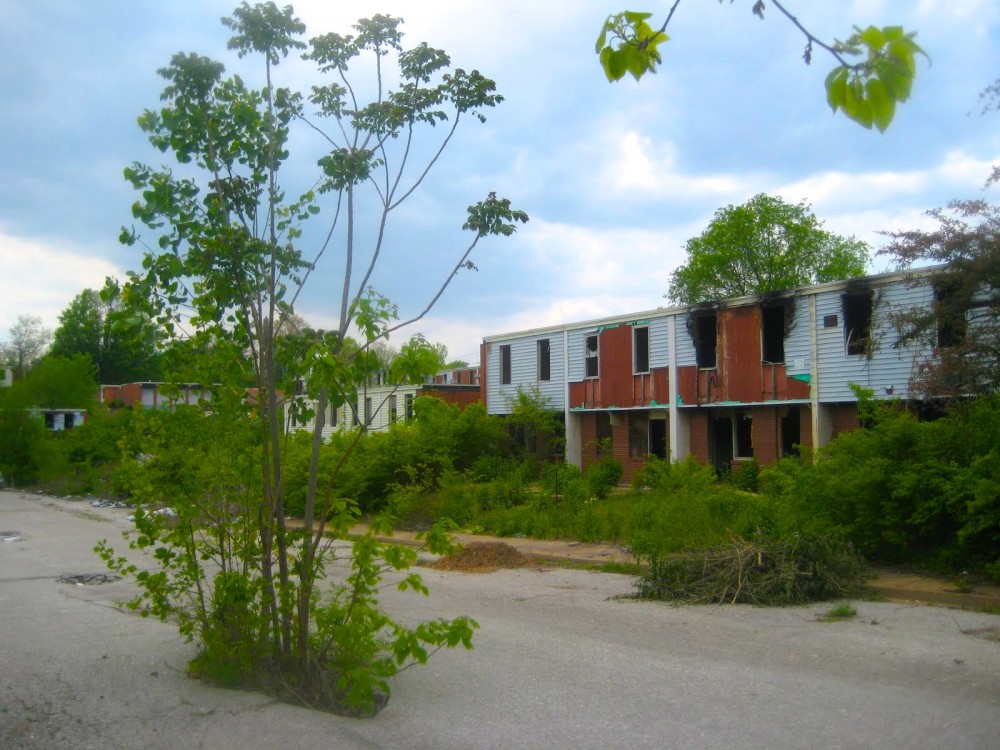
Longtime north St. Louis County resident Geralda Ray believes that the focus of the protests in the suburb of Ferguson should stay centered on the death of 18-year-old Mike Brown.
But as she held her sign near the spot Brown was killed earlier this month, Ray thought about the Missouri town of Kinloch: a place she had once called home.
Like most residents of Kinloch, Ray had been forced to relocate after a buyout program bought up most of the land to expand the adjacent airport. Many of those from Kinloch were forced to move to other nearby municipalities such as Florissant, Berkeley and Ferguson, where historic laws had long forbidden black citizens from owning land.
Many ended up in the Canfield Green apartment complex, where Mike Brown lived and died.
So when protests erupted over Brown’s death, some former residents of Kinloch were more than ready to carry its memory with them in the streets.
“I used to live in Kinloch,” Ray said. “You should see my old apartment. There’s nothing left.”
Once a vibrant, self-sustaining, middle-class community of thousands in north St. Louis County — and also the first incorporated black community in the state — Kinloch was effectively reduced to a collection of overgrown vacant lots, decaying streets and abandoned buildings. It’s illegally used as a dumping ground for trash, old furniture and even bodies.
Only minutes from the protests in Ferguson, the near-vacant city has long been a symbol of what many African-Americans in north St. Louis County feel is representative of a social and governmental system in which they have little voice and that they say consistently works against them.
Some 30 years ago, the City of St. Louis started a buyout program in Kinloch to collect land in order to build a new runway at the Lambert-St. Louis International Airport. While voluntary on paper, those who lived there at the time describe the atmosphere as “arm-twisting.”
Eminent domain was in the back of everybody’s mind.
“Whether you chose to accept it or you chose to fight it, you knew eventually you’d have to leave,” Steven Peebles, who grew up in Kinloch, told Al Jazeera in April as part of a look at Missouri’s disappearing black towns. “There was this feeling of helplessness. We were essentially and effectively gobbled up.”
“The airport took that sense of community,” he added, “and eradicated it.”
In 1980, more than 4,000 people lived in Kinloch. Today there are not even 300, and the entire municipality has been reduced to less than one square mile of land, drained of most of its tax base. What used to be streets lined with houses, churches and corner stores now resembles an undeveloped plot of land, sprinkled with decaying buildings and cracked, empty streets. Much of the land belongs to the City of St. Louis.
Nearly the entire town was torn down to accommodate a runway that, in the end, was never built. The ground shakes when landing planes pass over, an ironic homage to the fact that the city’s first airstrip was in Kinloch, a point of pride for many of its former residents.
Tony Ambus, a long-time resident of the area who was also out protesting in Ferguson, knew the story of Kinloch well.
“What they did in Kinloch,” he said, “was destroy the sense of community there.”
Umar Lee, a life-long resident of north St. Louis County and local writer, told America Tonight that a sense of displacement has contributed to the frustration in Ferguson and is now being broadcast all over the world.
“You have a lot of displaced youth,” Lee said. “Either they came from Kinloch, or their families came from Kinloch. You know, a lot of these families are so transient and moving from one apartment complex — like Canfield Green — to another.”
He added: “Just constantly moving and no real sense of place or direction.”
Lee and the Al Jazeera film crew were later threatened by two Kinloch police officers for filming a sign on one of its abandoned streets. In recent years, the remnants of the city have become notorious for crime and violence, due to the abandoned buildings, former Kinloch residents said.
“You want to know what they did to that church?” Ray asked of the Catholic parish she and her children went to when they lived in Kinloch.
A scowl formed on her face. “It’s a nightclub now.”
Kinloch, Lee said, is one of the many factors playing into the protests in Ferguson. To understand Ferguson, one must understand Kinloch.
“It’s not just Mike Brown,” he said. “It’s life — times of bad dealings with the police and seeing your family dealt with by the police in that manner. It’s so many things, and it’s not just Mike Brown.”
“[Kinloch] is an issue they had back then,” said a Ferguson protester named Susan, who wished to have her last name withheld. “They tried to brush it under the rug there. Now it’s back up in their face.”
Susan was a property manager in Kinloch for several years. The apartment complex she managed was foreclosed on, and she was charged with the task of evicting its residents.
“They didn’t understand,” she said softly. “It was home to a lot of people for generations. They were heartbroken. That was their home.”
For those who lived in Kinloch, the city was the village it took to raise their children. It’s a community many are nostalgic for, and many who lived there feel the system that took Mike Brown is the connected to the one that bulldozed their hometown.
“It’s a festering wound,” Susan said. “They feel like they weren’t ever heard.”
3 WAYS TO SHOW YOUR SUPPORT
- Log in to post comments












